data
Can connected technologies solve the problem of drug adherence?
Non-adherence to treatment regimens costs healthcare systems hundreds of billions of dollars every year. Elly Earls finds out how an Internet of Things-powered solution proposed by Vodafone could help.
Anyone who has been prescribed a drug to take on an ongoing basis will remember a time they forgot to take their medication. Most probably didn’t give it a second thought and are even less likely to have realised that their non-adherence is part of a multi-billion dollar problem facing the healthcare sector, one that results in hundreds of thousands of deaths every year.
According to a new Vodafone white paper the lack of medical adherence leads to 125,000 deaths per year in the US alone, accounting for 69% of all medical-related hospital admittance and costing payers up to an estimated $290bn each year.
For severe asthma, estimates suggest that the savings produced by optimal control would be around 45% of total medical costs, while improved medication adherence among patients with diabetes could result in over one million avoided emergency department visits and hospitalisations in the US annually.
The whys behind the problem are complex. In fact, there are over 700 identified reasons for non-adherence, ranging from concerns about side effects to bewilderment over complex treatment regimes. The only universal fact is that each individual patient is different, and therefore needs an individualised solution.
The concept of smart adherence devices
The good news is that a number of different factors are in the process of coming together to make a new approach to adherence – an Internet of Things (IoT) enabled, and therefore much more personalised one – not only possible but inevitable.
IoT sensors are getting smaller, more advanced and cheaper; connectivity is ubiquitous, fast and secure; cloud hosting is scalable and cost-effective; and the technology platforms that enable the development of novel solutions to measure patients’ adherence and engage them in improving it are ready to go. Not only that, but patients are ready, too; the likes of Fitbits and sleep tracking apps have opened their eyes to the value of being in tune with their physical performance and health, and therefore better able to improve it.
Smart adherence solutions work on the same principle. Data is collected by tiny sensors in pill packets or medical devices to be analysed and then shared with patients via apps on their smartphones, the idea being that showing them that they’re not following their treatment regime would provide a stronger impetus for them to do so.
“To engage, patients need to feel that they are part of the process,” says Jon Lee-Davey, IoT health lead at Vodafone. “They also need to feel that the process is considerate of their own personal needs. By having a connected solution, we would be collecting pertinent data about that particular patient, making them feel like they have some ownership and are empowered to be able to take control and begin to manage their own condition.”
Data is collected by tiny sensors in pill packets or medical devices to be analysed and then shared with patients via apps on their smartphones.”
For example, if a patient continued to miss their medication on Mondays and Wednesdays because of, say, football practice, the technology could suggest they adapt their schedule to better suit their lifestyle. “It’s about having that feedback loop that allows it to be put in the context of the patient. That’s where it becomes that much more powerful,” Lee-Davey says.
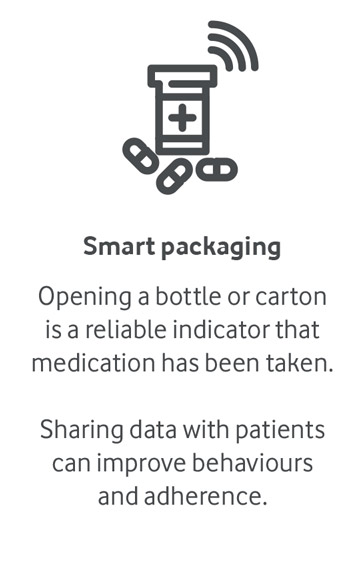
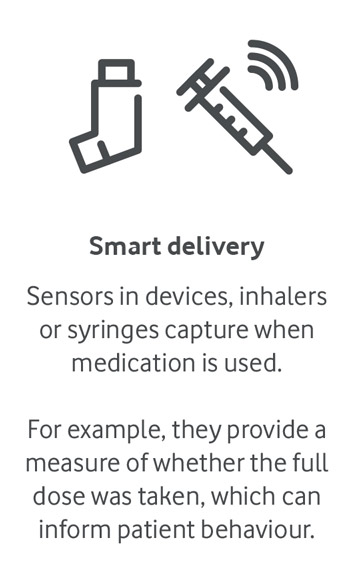
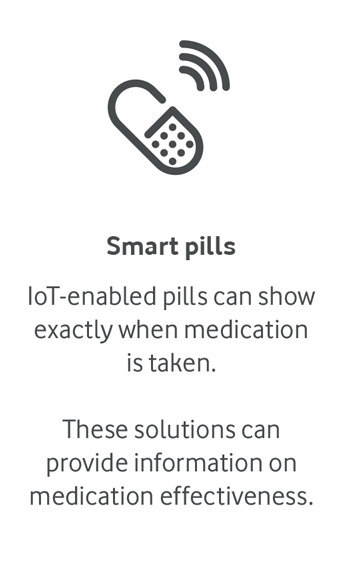
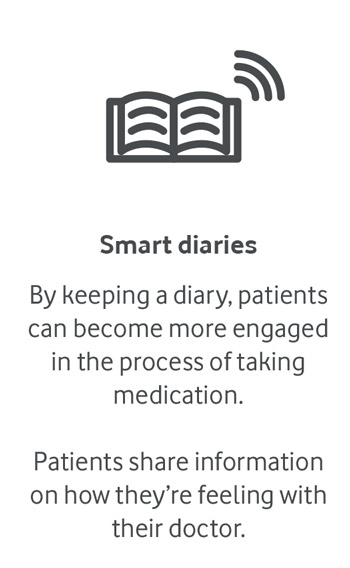
Source: The missing link in healthcare - Vodafone
Healthcare benefits of better data collection
The benefits of IoT-enabled adherence technologies would extend far beyond an improved patient experience. Armed with better data, doctors could make better decisions, while payers could make significant savings from a reduced need for stepped care.
“If patients aren’t taking their therapy, it might be that their disease progresses or their doctor recommends them to move into a third or fourth treatment, which could be more expensive,” explains Lee-Davey, who has been invited to speak to the European Parliament about the role the IoT could play in helping to share future European healthcare policy, evidence of just how seriously world leaders are taking this issue.
Plus, over time, an amount of data would be amassed that could be used to inform clinical research.
“One of the challenges of running clinical trials is that the data may be incomplete, and how do you test your hypothesis if you have an incomplete data set?” Lee-Davey asks. “Being able to gather accurate data during an expensive research process could lead to the development of better solutions and therapies.”
Over time, an amount of data would be amassed that could be used to inform clinical research.
According to Vodafone’s white paper, entitled ‘The missing link in healthcare’, around half of patients being treated for long term chronic illnesses such as hypertension, cancer or HIV don’t stick to their recommended treatment programmes. Better approaches, those that connect the different technology dots in the treatment process, it claims, could bring 50% of the non-adherent population onside, potentially improving millions of lives and saving billions of dollars.
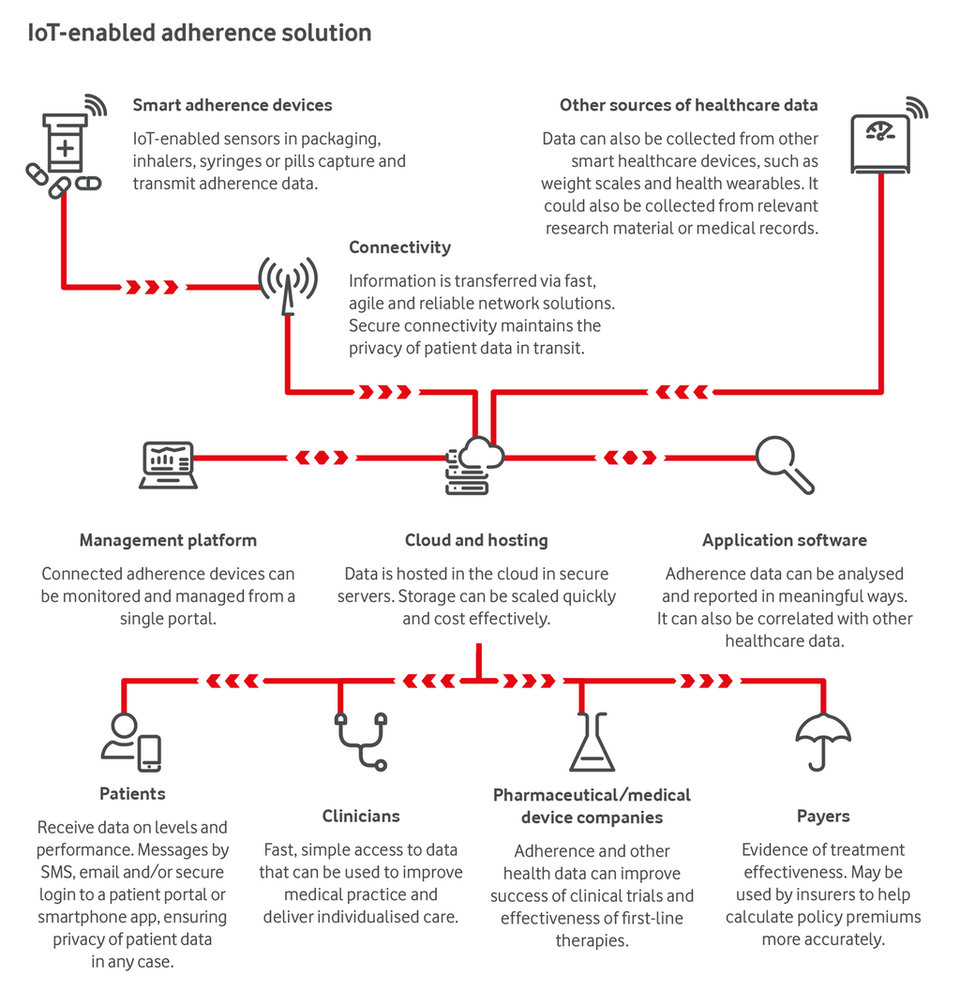
Source: The missing link in healthcare - Vodafone
IoT-powered healthcare: The next logical step?
We’re seeing personalisation creep into all aspects of healthcare – from tumour treatment and therapies for cystic fibrosis to voice assistants that can communicate with elderly patients in their own homes. Expanding this approach to medical adherence is the next logical step, and one Vodafone, as a technology and infrastructure provider, is working to help make a reality.
Already, the company, which connects 59 million ‘things’ via its Global Data Service Platform (GDSP), more than any other company in the world, is helping to encourage adherence by providing connected solutions around sleep apnea and cardiac rhythm management devices.
Lee-Davey and his team see no reason why they can’t be the ones to bring together pharmaceutical and medical device companies, healthcare systems and technology companies to facilitate an industry-wide move towards individualised – and therefore much more effective – adherence solutions for drug regimens and other medical devices, too.